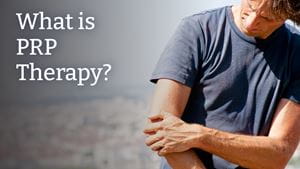
Platelet-rich plasma therapy is a way to use the body’s natural healing capabilities and direct them at a specific injury or disease. Initially the treatment was used to help treat male pattern baldness, but it has since shifted toward being used as a effective orthopaedic therapy.
For people who are dealing with pain in a tendon or joint and have tried cortisone injections and physical therapy, this may be a viable next step to help with any injury.
Daniel Day, DO, is a Sports Medicine Specialist with Rochester Regional Health. He shares how the therapy works and who it can work on.
A platelet-rich plasma (PRP) injection is a form of therapy that involves taking platelets from a person’s blood and putting them back into their own body. The treatment helps the body heal and regenerate damaged or degenerated tissue more quickly.
Platelets are a type of blood cell that are told by a person’s body to go to the site of an injury. Once platelets arrive at the injury, they help that part of the body heal more quickly by activating inflammation and bringing in cells to help repair it.
Plasma is the liquid portion of blood in the body. When separated from the red and white blood cells, platelets, and other cellular matter that comprise blood, it is a light yellow color.
During a PRP injection, a patient first has their blood drawn and put into vials. The vials are then placed into a centrifuge and spun around at a high speed to help the platelets separate from other blood cells. Once the platelets are concentrated together, they are extracted along with the patient’s plasma.
An ultrasound or X-ray image is taken to locate the best place on or near the patient’s injury to inject the plasma. The platelet-rich plasma is then injected at the injury site.
The entire injection process takes approximately one hour.
“It gives a pretty safe and reasonable option where you can fix your problem,” Dr. Day said. “A lot of patients come in and they’re frustrated because they’ve tried all of these different things. And here you have an option you can provide them that can give them the health benefit and get them over that hurdle.”
Consulting with an orthopaedist is often the first step in the process.
Patients who have injuries to tendons, ligaments, knees and elbows, tennis elbow, or other orthopaedic conditions such as osteoarthritis or bursitis are often candidates for PRP therapy.
There are factors that can affect or reduce the effectiveness of PRP therapy. Those include:
Most insurance carriers do not cover PRP therapy, but it is best to check with your provider first before moving forward with the procedure. While PRP injection treatments are often an out-of-pocket cost, Rochester Regional Health works with patients to be as cost effective as possible.
Some generic medications should be avoided for two weeks before and after the injections since the treatment itself tries to stimulate a healing response instead of simply reducing inflammation.
These include:
Patients who are on multiple anti-coagulants or have a low platelet count should consult with their primary care provider or cardiologist about any possible changes to their daily medications.
Aspirin should not be taken for 72 hours before the procedure.
Do not drive to the appointment; someone will need to drive you home. You are allowed to eat and hydrate yourself before the procedure.
Once the procedure is done, the R.I.C.E. recovery method (Rest, Ice, Compression, Elevation) is encouraged to help manage pain. Any NSAID medications should be avoided for a minimum of two weeks – ideally six weeks.
Aspirin should not be taken for 48 hours after the procedure.
Most people are able to return to work or school the following day. If a note is needed to excuse you for a day or two, ask your doctor.
The results of the injection are not immediate. It often takes at least 2-4 weeks for a patient to get back to where they were before the injections.
“The therapy helps to speed the body’s recovery process, but the injury itself still needs to heal,” Dr. Day said. “Some patients report feeling better after a few weeks or months. It varies for person to person.”
If you start to experience severe pain in the early weeks following the treatment, contact your primary care provider.
Working with a physical therapist is an important piece of recovery. Your PT team will help to set goals to gradually work up to a more normal range of motion and improved strength.
The PRP therapy uses a patient’s own cells to help heal their own body. As a result, the procedure is a very low risk one.
Some of the more common side effects of PRP therapy include: